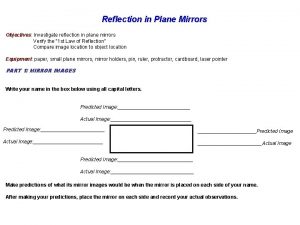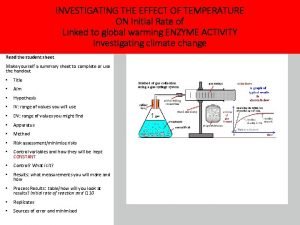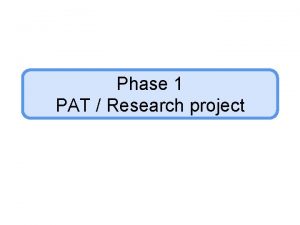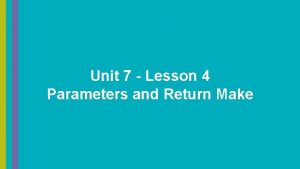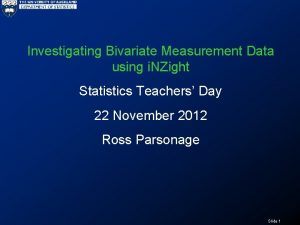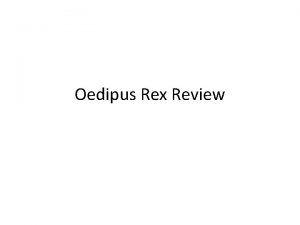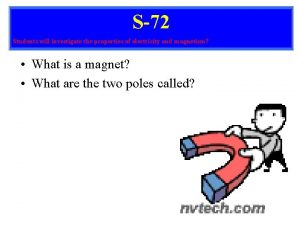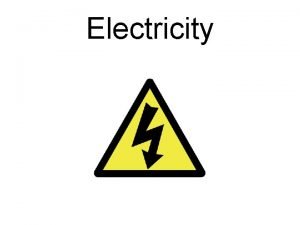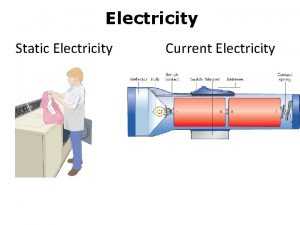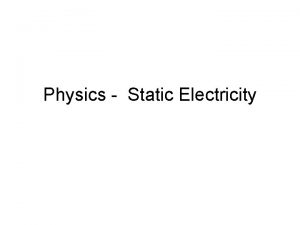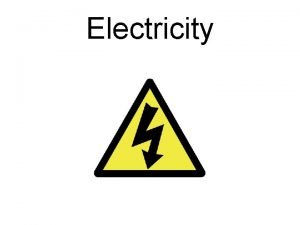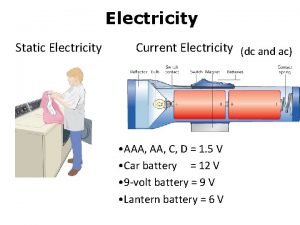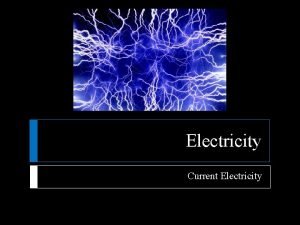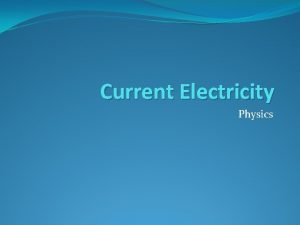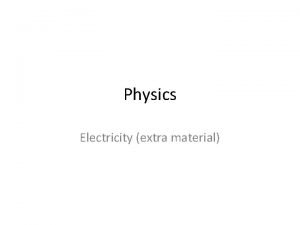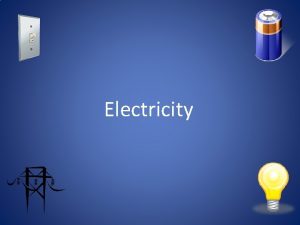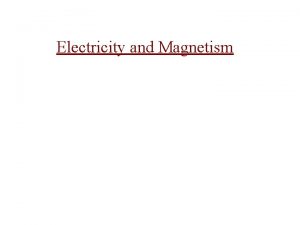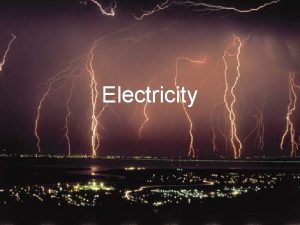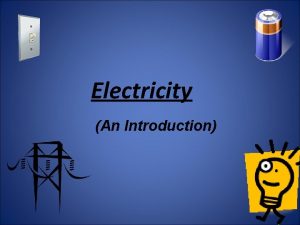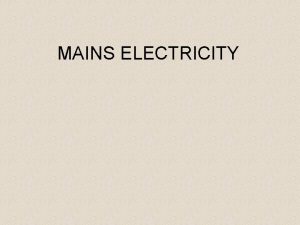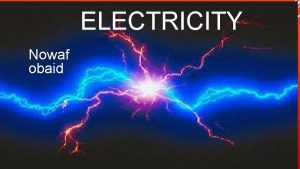S66 Students will investigate the properties of electricity



























- Slides: 27

S-66 Students will investigate the properties of electricity and magnetism? • Explain briefly where electricity comes from.

Chapter 20 Electricity SPS 10 Students will investigate the properties of electricity and magnetism. a. Investigate static electricity in terms of –friction, induction, conduction b. Explain the flow of electrons in terms of -alternating and direct current -the relationship among voltage, resistance, and current -simple series and parallel circuits

20. 1 Electric Charge and Static Electricity What produces a net electric charge? What determines whether an electric force is attractive or repulsive? What determines the strength of an electric field. What are three ways in which charge is transferred. How does static discharge occur?

20. 1 Charge and Statics What produces a net electric charge? • Electric Charge – a property that causes protons and electrons to attract or repel each other – Two types – Positive - protons – Negative – electrons – An excess or shortage of electrons causes atoms to be charged – That causes objects to be charged

20. 1 Charge and Statics What determines whether an electric force is attractive or repulsive? • Electric Force – force of attraction repulsion between electrically charged objects – Like charges repel -positive, or – Opposite charges attract positive) or (positve negative-negative) (negative-

20. 1 Charge and Statics What determines the strength of an electric field? • Electric Field – the space around a charged particle where it will push or pull another charge – Depends on – Amount of charge – Distance from the charge • Drops off rapidly of the distance) (square

20. 1 Charge and Statics What are three ways in which charge is transfered? • Static Electricity – charges that are not moving • Law of conservation of charge – the total amount of charge stays the same – Remember that charge is protons and caused by electrons

20. 1 Charge and Statics What are three ways in which charge is transfered? • There are three ways that charge is transffered – Friction • Two uncharge objects rub against each other • Electrons are pulled off one object and placed on the other – Contact • A charged object comes in contact with an uncharged object • The charged object loses charge until they both have the same charge

20. 1 Charge and Statics What are three ways in which charge is transfered? • There are three ways that charge is transffered – Induction • Electrons in an object attracted or repelled charge • This causes a charge in a are by a temporary neutral object

S-67 Students will investigate the properties of electricity and magnetism? • What are the two types of charges? • What are the two basic charged particles? • How does a charge form?

20. 1 Charge and Statics How does static discharge occur? • Electrons will flow if there is a conducting pathway – Static discharge when a pathway between charged objects is formed • Shocking yourself a doorknob • Lighting bolt on

20. 2 Electric Current and Ohm’s Law What are the two types of current? What are some examples of conductors and insulators? What factors affect electrical resistance? What causes and electric current? How are voltage, current, and resistance related?

20. 2 Current and Ohm’s Law What are the two types of current? • Electric Current – the flow of charge – Two types – Direct Current • Flows in only one direction • Electricity from batteries – Alternating current • Changes direction in a regular pattern • Has frequency (usually 60 Hz) • Household electricity

20. 2 Current and Ohm’s Law What are some examples of conductors and insulators? • Electrical conductor – material that charge flows through easily – Metals – Graphite – Salt solutions • Electrical insulator – material that charge does not flow through easily – Plastics – Rubber

20. 2 Current and Ohm’s Law What factors affect electrical resistance? • Resistance – opposition to the flow of charge – Resistors use up the energy in electricity – Measured in Ohm (W) – Three factors affect resistance • Thickness – thicker objects have less resistance • Lenth – longer objects have more resistance • Temperature – resistance increases with temperature

20. 2 Current and Ohm’s Law What causes an electric current? • Voltage (Potential Difference) – difference in potential energy between two points – Units are volts (V) – Produced by sources of electric energy – A potential difference placed across a loop of conductor will result in a current – Current is measured in Amperes – or Amps (A)

20. 2 Current and Ohm’s Law How are voltage, current, and resistance related? • Ohm’s Law – current is equal to potential divided by resistance V=IR – V = potential difference in volts (V) – I = current in amps (A) – R = resistance in Ohm’s (W)

20. 2 Current and Ohm’s Law How are voltage, current, and resistance related? • What is the potential difference that would allow a 7 A current to flow through a 14 W toaster? V=98 V V=IR V=(7 A)(14 W) – Fill in the equation – Answer

20. 2 Current and Ohm’s Law How are voltage, current, and resistance related? • How much current would flow through a 96 W light bulb when it is plugged into a 120 V source? I=1. 25 A V=IR 120 V=I(96 W) – Fill in the equation – Answer

S-68 How are voltage, current, and resistance related? • A toaster is plugged into a 120 V wall outlet. How much current will it draw if it is a 47 W resistor?

S-69 What factors affect electrical resistance? • What three factors determine the resistance of an object? • How does resistance change as each factor changes?

20. 3 Electric Circuits What is included in a circuit diagram? How do series and parallel circuits differ? How do you calculate electric power?

20. 3 Electric Circuits What is included in a circuit diagram? • Electric Circuit – complete pathway – Circuit diagram – show the path and devices in the pathway – Common symbols are • • • Battery of cells Resistor Light bulb Switch

20. 3 Electric Circuits How do series and parallel circuits differ? • Series Circuit – Has only one pathway for current – If one device is disconnected they all stop working • Parallel Circuit – Has more than one pathway for current – Devices don’t affect other devices – Household circuits are parallel

20. 2 Current and Ohm’s Law How do you calculate electric power? • Power is equal to voltage multiplied by current P=IV – P = power in watts (W) – I = current in amps (A) – V = potential difference in volts (V)

20. 2 Current and Ohm’s Law How do you calculate power? • An electric oven is connected to a 240 V line, and it uses 34 amps of current. What is the power used by the oven? P=(34 A)(240 W) P=8160 W P=IV – Fill in the equation – Answer

S-70 How do you calculate power? • How much power would a hair dryer use if it draws 15 A of current when plugged into a 120 V wall socket? • Hair dryer –boring • Powerful tank - cool
 Electricity n
Electricity n Magnetism vocabulary
Magnetism vocabulary Static electricity and current electricity
Static electricity and current electricity Investigate reflection
Investigate reflection Initial rate of reaction
Initial rate of reaction How to investigate a problem
How to investigate a problem Lesson 4 parameters and return make
Lesson 4 parameters and return make Investigate bivariate measurement data
Investigate bivariate measurement data What does jocasta attempt to prove to oedipus
What does jocasta attempt to prove to oedipus How jose become the champion of filipino student?
How jose become the champion of filipino student? Intensive vs extensive
Intensive vs extensive Chemical property of matter
Chemical property of matter So nguyen to
So nguyen to Thiếu nhi thế giới liên hoan
Thiếu nhi thế giới liên hoan Tia chieu sa te
Tia chieu sa te Một số thể thơ truyền thống
Một số thể thơ truyền thống Các châu lục và đại dương trên thế giới
Các châu lục và đại dương trên thế giới Thế nào là hệ số cao nhất
Thế nào là hệ số cao nhất Hệ hô hấp
Hệ hô hấp Tư thế ngồi viết
Tư thế ngồi viết Hát kết hợp bộ gõ cơ thể
Hát kết hợp bộ gõ cơ thể đặc điểm cơ thể của người tối cổ
đặc điểm cơ thể của người tối cổ Mật thư anh em như thể tay chân
Mật thư anh em như thể tay chân Chụp tư thế worms-breton
Chụp tư thế worms-breton ưu thế lai là gì
ưu thế lai là gì Thẻ vin
Thẻ vin Bàn tay mà dây bẩn
Bàn tay mà dây bẩn Thơ thất ngôn tứ tuyệt đường luật
Thơ thất ngôn tứ tuyệt đường luật



